By: Rick Landers

Elliott Landy: Courtesy of Elliott Landy.
During the late Sixties, a young Elliott Landy landed the gig of a lifetime – Woodstock (1969).
Asked to photograph the spirited three-day gathering of “Peace and Music”, Elliott worked out an “all access” entry that allowed him free rein to memorialize the largest rock festival of all time.
Loaded up with canisters of film, Elliott worked his way backstage, up front and around some of the top artists of the day, including: Richie Havens, Janis Joplin, Carlos Santana, Country Joe and the Fish, Canned Heat…and more.
Roaming through his book, Woodstock Vision: The Spirit of a Generation, we’re gifted with images of Woodstock that capture moments of festival performers and staffers, and expansive crowds that filled the bucolic landscape. The book also includes more casual images of some artists of formidable talent, as well as striking confrontational photos of protesters and police.
The book historically informs, couching within its pages an array of musician heroes, like Jimi Hendrix, The Beatles, B.B. King, Eric Clapton, Janis Joplin, Jim Morrison, Frank Zappa, Doc Watson, Joan Baez, and of course, Bob Dylan and The Band. Inside Fillmore East, NYC, Elliott catches The Who, a group both strident and destructive in performance, and low key, nearly sedate, in more relaxed settings.
And the book’s story line weaves a path, taking us along to join him and it’s stunning in its reach, whether he’s at a Beatles’ press conference, looking up at the masterful folk-jazz-fusion master, Tim Buckley, or harnessing the energy of the legendary Pete Seeger, under some hot klieg-lights. Folkies get touching, poignant photos of Mimi Farina and Joan Baez, a phalanx of performers at The Newport Folk Festival that include: Arlo Guthrie, Alan Lomax, Ramblin’ Jack Elliott and more.

Jimi Hendrix, Fillmore East, NYC, 1968. Playing Gibson Les Paul. Photo By ©Elliott Landy, LandyVision Inc.
There’s more, much much more….but, better to have the book sitting on a nearby coffee table, to read and peruse, while contemplating days gone by or those of an earlier intense generation seeking to celebrate, as well as redefine or recalibrate the meanings of peace and love.
The year before, Elliott’s work earned its place on The Band’s debut album, Music from Big Pink, and in July 1969 Bob Dylan released his landmark album, Nashville Skyline, with Dylan’s gentle smile and tilt of a hat taken by Elliott in an impromptu moment.
In our interview, Elliott and I talk about his time with the newly formed group, comprised of a five earnest young men, Rick Danko (bass guitar, fiddle, vocals), Levon Helm (drums, mandolin, vocals), Garth Hudson (keyboards, saxophone, accordion), Robbie Robertson (guitar, vocals) and Richard Manuel (keyboards, drums, vocals).
His photos capture the group, in a homey, natural setting playing their instruments, or just as often, just hanging out. It’s this natural aura of the Landy’s images of The Band that feel as calm as a slow moving river, yet reflect a deep rooted honesty.
And Elliott’s book, The Band Photograph 1968 – 1969, features over 150 images of The Band members, their friends and families.
It’s a photo laden tome uncluttered, allowing readers to turn page after page of photos to focus on each image, to get into an emotional flow that takes us back to a time and place where music was played in a most natural and home spun way.
With introductory and exit commentaries, Elliott sandwiches the bulk of the photos with the story surrounding his time both before and well after his late Sixties experience, offering readers an exquisite solitude of one-on-one with The Band. And at the end of his very cool book, he offers brief descriptive notes for each photo, but with the images reduced for a compact, more informed review.
Today, Elliott Landy is not resting on his laurels, but remains a hard working, professional and relevant gentleman in our new world of high technology and global connectedness.
Along with his beautiful books, he has plans for an overseas series of exhibitions, is developing an interactive performance project and is collaborating with others on an app of his own design. His creativity, inventiveness and imagineering in the world of music and art have always been drivers harnessed to the practical, with successful results achieved. Stand by for more to come!
CHECK OUT ELLIOT LANDY’S NEW KICKSTARTER CAMPAIGN FOR “CONTACTING THE BAND” BOOK!
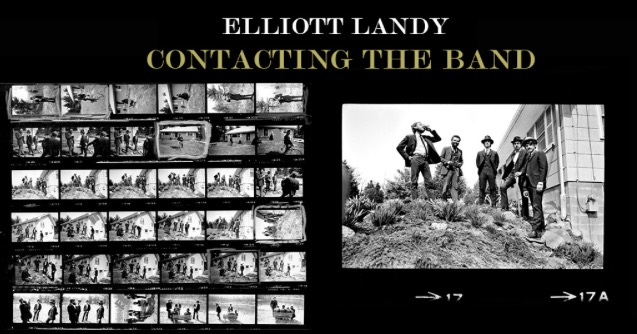
******
Rick Landers: I was talking to a friend of mine and told him, “You know, we tend to remember not so much the days of our lives, but special moments.” That kind of ties into what I think you do as a photographer. You’ve capture many special moments, and I wondered if, when you do that, do you know how special the moment is or do you in retrospect say, “Wow, I’m lucky I got that one,” or, “Wow, I just grabbed a great moment.”?
Elliott Landy: Well, the question is, do I know that the situation itself is very special? Are you asking me about a specific photograph that I’m taking?
Rick: I was thinking a specific moment, which would be the photographs, but I think possibly an event like Woodstock, or you’re hanging out with somebody and you know there might be something special about that particular situation, so probably both.
Elliott Landy: I don’t think like that. The best example I could give you is when I first started doing photography. Like when I was photographing Bob Dylan for the first time for a Saturday Evening Post cover.
I barely spoke to him before we started taking pictures. He was sitting, maybe, 10 feet from me. He was leaning against a construction sawhorse that was just out in his yard. There was firewood all around, chopped up.
He just started singing and playing his guitar, and I was just taking his picture. I knew that it was a very special moment, but it just felt totally normal to me. I thought, how much, how valuable, how precious would this be to so many people in the world, to be 10 feet away from him while he’s singing and playing the guitar?
But, to me it felt normal; it didn’t feel special. I was just taking the pictures and focusing on the image itself. But, I realized it was very special.
At the time it didn’t strike me emotionally; I wasn’t nervous. I didn’t feel any differently than taking a picture of a leaf, let’s say [Rick laughs].
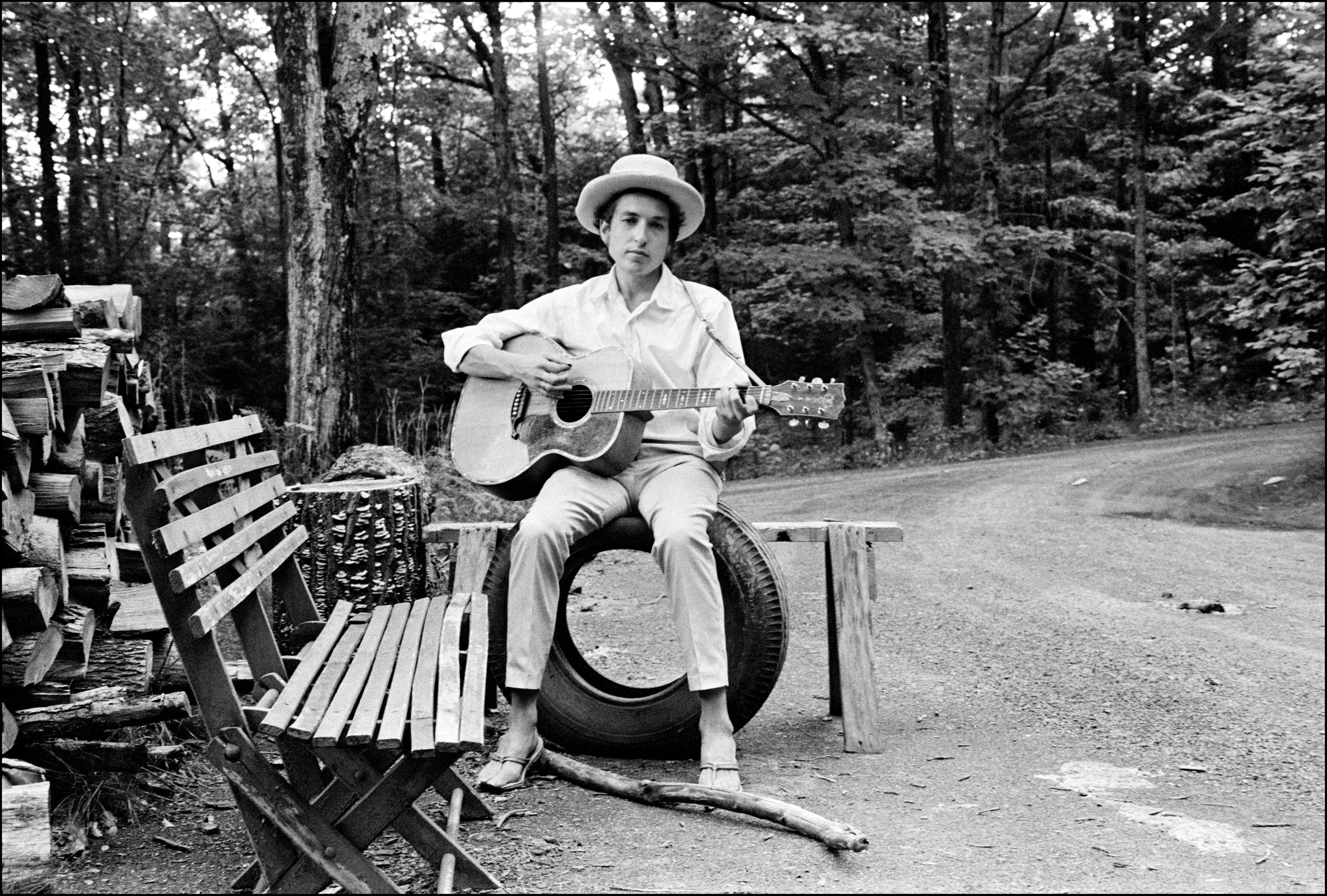
Bob Dylan, outside his Byrdcliffe home, Saturday Evening Post session, Woodstock, NY, 1968. Photo By ©Elliott Landy, LandyVision Inc.
To me, I guess they’re all elite, but there was no emotional weight to these moments for me. Perhaps that’s because I was totally concentrating on being in the picture when I take the picture. My whole attention is on the composition of the image.
I don’t usually talk very much when I take pictures of people. I don’t use conversation to make someone feel comfortable or to make someone feel good or to make them smile. I don’t tell jokes and so on. I let people be who they are.
I think that’s why I got along with Bob so well, because I didn’t try to maneuver him. I didn’t try to manipulate him. I think a lot of times a photographer tries to manipulate the subject into being a certain way or doing a certain thing, and so on. I don’t do that.
I let them do what they like, even to the point of if I’m photographing someone, I just let them stand the way they want to stand and hope that it comes out well. If I see that it’s not, now that I’m older and more experienced in life I guess, then I’ll say something or suggest something. But, I prefer not to say anything, so you really get who the person is, rather than who I am.
Rick: Has that changed over the years? I assume you’ve done more than one shoot with Bob. Do you find that you’re in a friendship type of situation? Are you comfortable…
Elliott Landy: I actually only did two shoots with him: one for the Saturday Evening Post and one for the Nashville Skyline (1969) album. Both were exactly the same; we just hung out. He stood where he wanted to stand. The story’s in my book.
I let the person I’m photographing lead the way and take the lead. I just follow and I take pictures and they do what they do. When that doesn’t work, then I can go beyond that. The photograph of The Band that was taken for Music from Big Pink (1968), the story of that is in the book also – but basically we had done two previous shoots. Can’t use the word shoot anymore!

Bob Dylan, Ohayo Mountain Road home, Woodstock, NY, 1969. Photo By ©Elliott Landy, LandyVision Inc.
Rick: Right, Okay, which I just did. [Chuckles]
Elliott Landy: We had done two previous photo sessions and got some really nice pictures. But, the guys felt it wasn’t right for the album, it wasn’t what they wanted for the album. I then had to think about it. I’ll try and avoid thinking at all costs usually [Both laugh], except for the technical parts.
That’s pretty much the challenge to get that right. Of course, it used to be. Now it’s easier. Everything’s automatic now. To get really good pictures you may set the exposure slightly different, so that it makes something more dramatic, rather than mundane. It still takes knowledge of how to use the controls of the camera.
I got some really great shots and they liked them, but they just didn’t have the album cover. So, I had to think about it. I had to create a look. I had become familiar with them at that point and I had experienced them, and they were very grounded people, exceptionally so.
They were loyal people, I believe most of them grew up on farms. They were very straight ahead in terms of what they said to people. They were respectful to people, to everyone. There was no difference in the way they treated a clerk at the grocery store compared to a record company executive.
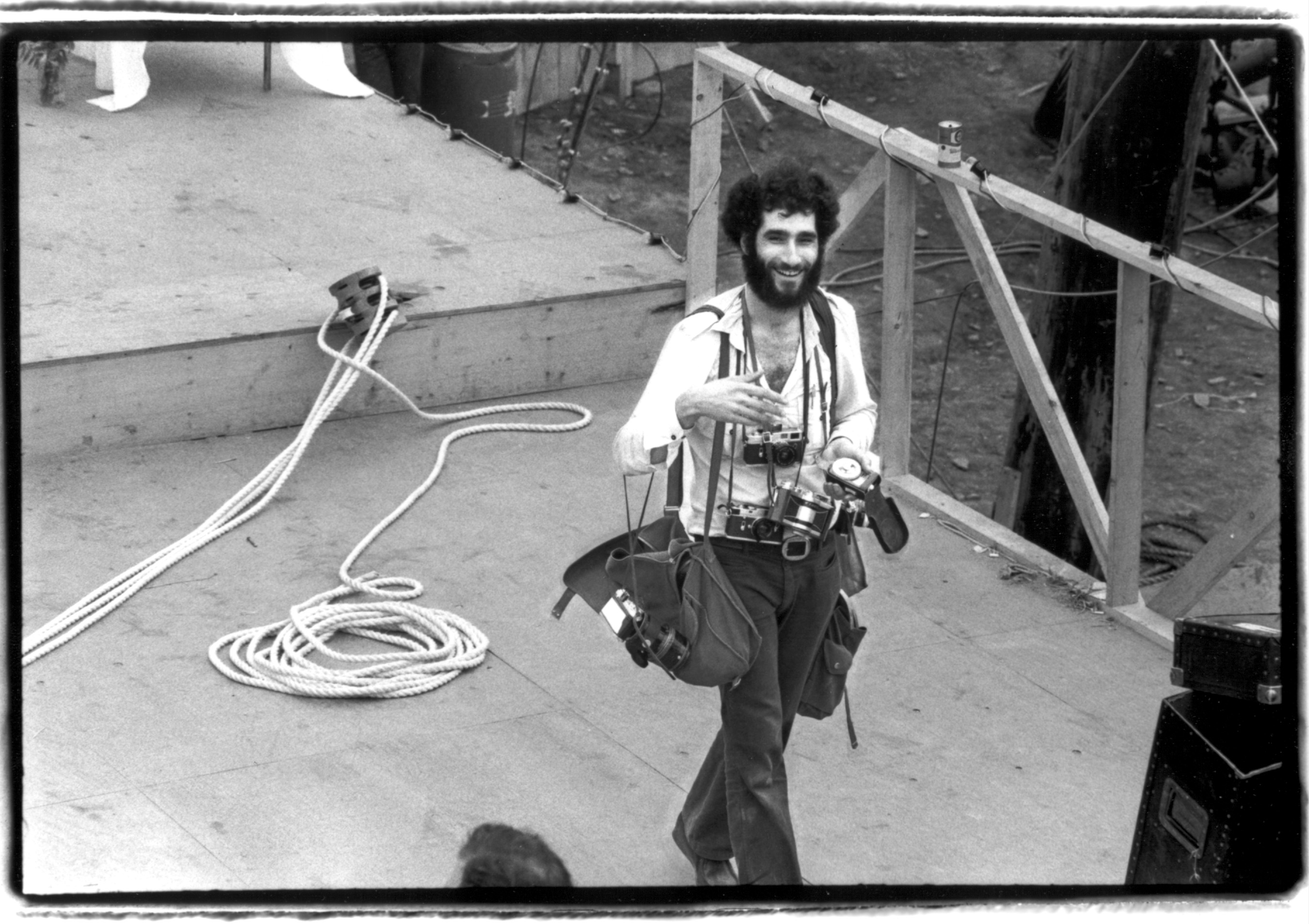
Elliott Landy – Photo credit: © Amalie R Rothschild
To my perception, they had a sincere appreciation of meeting another human being. That was quite nice. It was the old-fashioned way, especially in the ’60s when everybody was saying, “To heck with you!” “I don’t like my family,” and everybody was against everything.
The ’60s was: we’re against the Vietnam War and we’re against the government, which was very appropriate, very necessary, but that was just a mood. They were just from another space, where you didn’t run around speaking out about things.
At the same time, just by chance, I had gotten this book of photographs: Civil War photographs taken by Matthew Brady and his associates. I saw that that style of photography would be perfect for who these people were, very grounded, very formal in a way, but very organically formal.
You don’t come into the picture saying, “I’m going to put three people in the back and two people in the front and now I’m going to stand 10 feet away and take their pictures from head to shoulders.”
That’s the style of a formal picture from the Civil War era of photographs. I wanted it where the landscape defined the picture: where the people stood, where the photographer stood. Like there were people on the back of a steam locomotive, people on the roof of a house, people on one rock and someone else on the other side of the picture on another rock.
You can’t just stand in the middle of the frame to be photographed. I just felt that whole style was right. I had to figure that out how to imitate that old-time look, which I did bright, using a very slow shutter speed.
The hardest part was to find the right landscape. I needed to find kind of an unscathed landscape. It actually took a while to do that: by a while, I mean we had to drive around a few hours, and we couldn’t find anything.
We went back to the house that Levon (Helm) and Rick (Danko) were sharing. We were just hanging out in the living room and looked out the front window and there was the landscape that I had been looking for right in their front yard [Rick chuckles]. So, in that case, I did control it, and said, “You’ve got to do this and this.”
I told them, like in the old days, that when a photographer showed up, it was something unusual. Everybody honored the photographer. They paid attention to the photographer. They got dressed up for the photographer. There was no turning your back to them or things like that. You weren’t casual. You are very formally attentive to having your picture taken. So, we got the attitude there, I think. And then we took the picture.
Sometimes when I have to control it, I can. I’ve done a few other things like that in my life and it worked out quite nicely. I’m an easygoing person, so if I can make it easy on them where they don’t have to think about it, I will. I actually think it’s better to photograph someone in their natural environment, where they live and stuff like that. I always try to do that first
Rick: What came to mind when you were talking about “organically formal”was the Deja Vu album – if you remember that, with Crosby, Stills, Nash and Young, and probably Reeves and Taylor, I guess. That’s pretty staged, and they’re wearing older clothes. Yours still looks more natural than that. Deja Vu was more of a portraiture kind of scenario.
Elliott Landy: At the time, I was told that it was inspired by my picture of The Band.
Rick: Really? Cool.
Elliott Landy: I’m not sure if it’s true. You’ve got to ask them. You know, I should ask Graham. I’m friends with Graham Nash. I should ask him, actually, where that idea came from.
Rick: Oh, that’s interesting. That would be cool to know.
Elliott Landy: Because The Band picture came out first. I’ve never mentioned it before now actually.
Rick: Really?
Elliott Landy: It was an inspiration.
Rick: I’m glad I brought it up. Interesting.
Elliott Landy: I’m sure some of them must have spoken about it over the years.
Rick: I guess. I’m an old-timer, so I remember albums like that. When you talk about the graininess and the black and white, that just came to mind.
Let me ask you about one of the photos in your book. It’s The Band. They’re on a bench and they’re not facing you. Was that staged? They were just squashing themselves together on that bench by a lake.
Elliott Landy: That bench and pond were in their backyard. Like I said, when I photograph someone I start with where they live. We were walking around. We did a few in front of the house and whereabouts.
I found this nice little spot with the pond and the bench there. I don’t know who suggested it. Maybe I did. I don’t really know about that. But, they didn’t all fit on the bench, which was what made it interesting.

The Band. Levon Helm, Fillmore East, NYC, 1969. Photo By ©Elliott Landy, LandyVision Inc.
Rick: So, you were there specifically on an assignment. You weren’t just hanging out with The Band.
Elliott Landy: Yeah, it wasn’t quite an assignment. It was like, “Go up and take pictures.” [Both chuckle] There was nothing talked about. The music wasn’t talked about. Again, they were saying they need pictures, so first I went to Canada and I photographed them with their families or next of kin. A few weeks later, I went up to Woodstock, which is actually just down the road from where I live, two miles down the road – very close, same area.
Rick: It sounds like even though it was an assignment, you were kind of hanging out with them and there was a bit of serendipity ruling the moment.
Elliott Landy: Yes. We were very comfortable with each other right away. They invited me to stay over at their houses and stuff, so we were very comfortable. Because they read people and I was just there as I always am just to get a good picture; of the situation is to get a good photograph, and I don’t get in people’s way, and I don’t start talking about myself, unless somebody asks.
They knew I had no other agenda. I was basically there for them to get them what they needed.
Rick: That gives a certain comfort level, I would think, even for you.
Elliott Landy: Yeah. I want to say that part of what made them comfortable was that I didn’t want to force them into a pre-conceived vision. I didn’t want to say,”You stand on your head over here, you stand on your head over there and hold two fingers up in the air, blah blah blah.”
I wanted the picture to express who they were. The way that I do that – it’s not even conscious, it’s my natural way – it’s just to let things flow.
Rick: And it sounds to me like they recognized that you weren’t trying to package them in any way. You just wanted to get them the way … like you say, organic. You were getting them how they were, which is very honest.
Elliott Landy: And it turned out to be the best packaging that they could have gotten in the end, that whole look and feel with them.
Rick: Do you play guitar or anything? Or when you’re hanging out, you’ve just got your camera with you?
Elliott Landy: No, I don’t play an instrument like that. I have made my own music, but it was after that time. Nothing to do with really making music. I walked into a music store in Germany. I sat down at an organ. I started pressing buttons [Both laugh heartily].
And the second time I bought like a half-track tape recorder. I ordered it. It’s really quite good music. I’m now recording other tracks to it. I’m having other people record to it. It goes with the film that I’m making. It’s very interesting, but it goes back 30 years now.
Rick: Wow. Well, if you get that out and it’s like a commercial thing, let me know and we’ll do a piece on that.
Elliott Landy: Thank you.
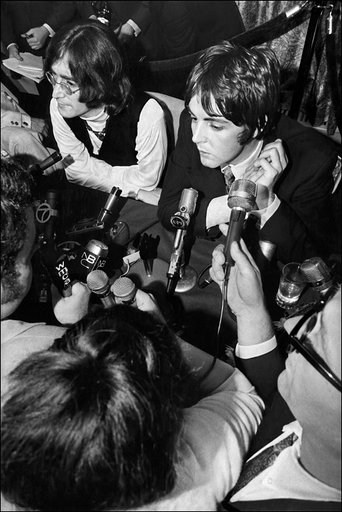
John Lennon, Paul McCartney, press conference announcing formation of Apple Records, NYC, 1968. Photo By ©Elliott Landy, LandyVision Inc.
Rick: How did you become the official photographer for Woodstock? It’s probably in your book, but I haven’t looked at your book in a couple of years since I first read through it. So, how did that happen? And did you grasp – maybe nobody grasped how big it was going to be before it actually happened.
Elliott Landy: Basically, I knew Mike Lang (Co-creator Woodstock 1969) from around town. I knew him casually through my sister. She had a girlfriend who was his girlfriend. We used to hang out on the town square and chat sometimes. I had no idea what he did, at all. He hadn’t done Woodstock yet. He knew what I did; by the time I was living in Woodstock, I had already done The Band photographs and Nashville Skyline, as well. But, he hadn’t made Woodstock yet.
Anyway, so we were casual friends. There was a really good feeling between us. One day he called up and said, “I want to come over and talk to you for a minute.”
So, he rides up to my house on a motorcycle and says, “I’m producing a concert. Do you want to photograph it?” I asked who was playing. He told me a few of the acts. I don’t remember which one’s he said, but I said, “Sure. Absolutely.” He says, “Great!” And he drives off. There must have been more to it than that as far as casual conversation. As I say in my book, it wasn’t even a handshake. We both said something, that was it.
Rick: Your word was your word back then and it should be now, right?
Elliott Landy: I wasn’t even promising him anything. It was just like, “Okay, cool. I’ll be there.” I didn’t even sign a contract.
Rick: Serendipity again, right? [Laughs] That’s funny.
Elliott Landy: So, that’s the reason I say I was the official photographer. He asked me to photograph it, so I guess that makes it official.
Rick: Yeah, I would say so. As Woodstock was going on, there was so much life going on around you and so many celebrated musicians. Were you given any game plan or did you just kind of go with it and wing it?
Elliott Landy: That’s what I did. I went with it and I wung it [Both laugh]. Everyone, Mike (Lang) and John (Roberts) and Joel (Rosenman), they had their hands full.
Mike said to the stage crew, “Let him up anytime he wants on stage.” Which was good and bad – It was good because I was onstage so much, but it was bad because I didn’t spend enough time with the people out there, because I had access.
Also to talk about the Woodstock thing and serendipity, the reason that Mike came up to Woodstock – at least I think so – was because it was a music mecca at the time. He was down in Miami. I don’t know really why he came to Woodstock, but Woodstock was known because of my photographs of The Band and Dylan. There weren’t that many of them, but it was like the least kept secret, in a way, of the time. It was like, this was where it was happening.
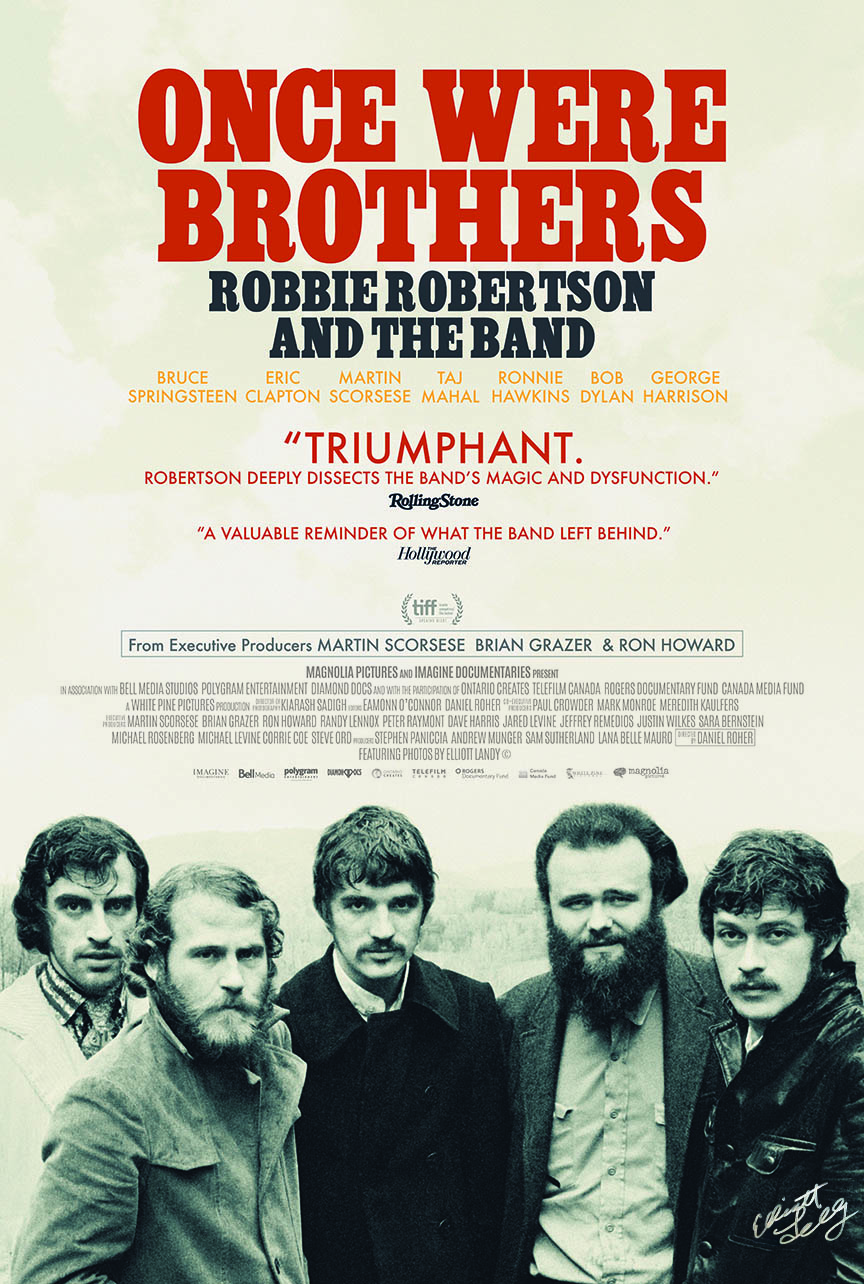 Peter, Paul and Mary, all around Albert Grossman. Pete and Mary came up there. It was just known as a music place mainly because Dylan moved up there. He had been living there for a while and that’s why it became THE place to go.
Peter, Paul and Mary, all around Albert Grossman. Pete and Mary came up there. It was just known as a music place mainly because Dylan moved up there. He had been living there for a while and that’s why it became THE place to go.
But, there were no pictures involved before the images of mine came out. So, the whole style of images that we created there kind of gave the place the vibe: the country vibe, but not country music – I don’t know quite how to say it.
Rick: Yeah, it’s become a bit of a mecca, I guess because of Woodstock. Doesn’t Marshall Crenshaw live there as well? I interviewed him. I thought he mentioned he lived there.
Elliott Landy: I don’t know. He could. I just found out that Marshall Chess lives near here. He lives in Tunisia which is a town 10 or 15 miles away.
But, I don’t know about Marshall Crenshaw. There’s a lot of people around and I don’t get out that much anymore. I’m so busy and we really don’t hang out too much during the week.
Rick: Was there a low point at Woodstock – not just in photography, I guess, maybe both – that you missed somebody that you wish you would have gotten? Although you got a lot of great shots. I love the shot you got of Richie Havens coming back from his set.
Elliott Landy: I did miss a lot of stuff at Woodstock. It was almost the only thing in my life that I feel like I missed stuff at [Both chuckle]. What happened was, my girlfriend who I was living with at the time was part of a store in Woodstock. She was partners in a store. Some people that came from Woodstock told me that the store burned down at night.
I asked if anybody got hurt and they didn’t know anything, so I tried to call my girlfriend and I didn’t get an answer on the phone. I got too worried about it, so I drove back to Woodstock and I missed Saturday night.
I missed Crosby, Stills and Nash and Sly and the Family Stone. So, even though I have a lot of really good photographs and pictures that no one else has, I regret that I missed it. It wasn’t necessary, because she was fine.
Rick: But, you did the right thing.
Elliott Landy: I guess my nature is that I always put live people ahead of pictures.
Rick: It sounds to me like when you were talking about so many different things going on, you may have had this feeling, like sensory overload.
Elliott Landy: No, it wasn’t that. These days you have loud speakers everywhere and music everywhere and it could be a sensory overload situation. But, the music was if you were in front of the stage or in the field, you heard the music. No, I didn’t feel like any sensory overload.
Rick: So, it was more focused than what you might get these days maybe?
Elliott Landy: Yeah, and there was only one stage, basically. At Woodstock ’94 and ’99, there were multiple stages and multiple things going on at the same time, which there is now. So that concert – it was one space and one performance and that was it.
Rick: Did you get to meet many artists that you hadn’t before, like maybe Hendrix or Joplin or anybody else?
Elliott Landy: No, I actually wasn’t there for Hendrix either. That’s what I mean about regret.
Rick: Ugh. That’s painful.
Elliott Landy: Yeah, it is. I’m sorry about it, but my luck has been so rich. What I did get was so wonderful and it captured the feeling of the festival. I’m doing between three and nine exhibitions in the next year.
The exhibitions are based on my book, which is Woodstock Vision: Spirit of a Generation.
Rick: Yeah, it’s a great book.

Bob Dylan – Image courtesy of Elliot Landy
Elliott Landy: It’s not based on the 50th anniversary of Woodstock. The promotion mentions the 50th anniversary of Woodstock, the theme of the show that the promoters suggested is my book, because it shows the essence of the time. It shows the peace demonstrations. The other photographs of what was happening at the Fillmore East. It isn’t just about musicians and Woodstock. It’s really grounded; it’s a pretty big show.
So, Woodstock, yeah, it’s really too bad. But, I got to express what I wanted to express about the experience. I got what I needed or at least I can make do with what I got.
Rick: Yeah. When do your exhibitions start?
Elliott Landy: I think the first one is in mid or late May.
Rick: Let’s talk a little bit about photography and I don’t know how much time you’ve got here.
Elliott Landy: I like the questions you ask.
Rick: I like to come from different angles rather than, “What’s your favorite desert island record?” I hate those type of questions so I have to come at it from different angles. Kind of the same thing you probably do with photography – to be kind of unique and maybe interesting, even though you may be asking the same kind of thing and get kind of the same response. I want interviews to be fun for everybody, not just for me and my readers. I want you to enjoy it as well.
Elliott Landy: I actually don’t take pictures unless I’m enjoying it. I don’t get jobs, so no one asked me to photograph anything for them.
In my life, I arranged it so that I’ve actually turned away from things I didn’t enjoy. I didn’t want to do assignments, because I want to define what I’m photographing. I don’t want to photograph something just because I’ve got an editor or magazine who wants it.

Eric Clapton, Derek & The Dominos. Capitol Theatre, Port Chester, NY, 1970. Photo By ©Elliott Landy, LandyVision Inc.
Rick: I’m kind of in the same position with my magazine. I’m looking mostly for interviews that I want to do. And I looked at your book going, “Oh, Elliot and I talked about doing an interview a few years ago,” and it just never happened. I want to interview Jimmy Webb the “American songwriter”, you know, “By the Time I Get to Phoenix” and all that stuff that he’s done. Hopefully I’ll get to Jimmy soon.
Elliott Landy: Usually when I’m going to be interviewed these days, I ask the interviewer, “Please be sure you’ve read the book,” because I don’t like to talk about the same thing that I’ve written about and I’m not going to talk about it.
Rick: And it’s been a while since I looked at it other than thumbing through it real quick just before I got on the phone. It’s been a couple of years, but I get a lot of books coming through.
Elliott Landy: I figure you do.
Rick: One guy said, “Finally someone who’s read my book who’s going to review it!” It was Tom Wheeler if you knew him from Guitar Player magazine. He said, “You actually read the book.” I said, “Yeah, I read the book.” He was surprised, bless his heart.
Elliott Landy: I assume you’ve seen my book on The Band, haven’t you?
Rick: I have not seen that book.
Elliott Landy: I can’t believe it. It’s called The Band Photographs and it’s 160 pages. I made it completely by myself.
I did a Kickstarter for it. It was the highest-funded photo book in Kickstarter history. I think it still is. It did super well. It’s a gorgeous book. I have total control of it. I rarely use the word proud. I don’t mean pride in terms of…
It’s not the pride of having done something. I’m proud because it’s perfect work. It’s just like a good photograph, something you want to share, that you really want people to experience.
Rick: How did your book, Woodstock Vision come about?
Elliott Landy: The Woodstock Vision book, which I love, I reread it – it was written about 1994 and it was taken from casual rhymes I had done over the years. I just gave the editor a bunch of papers and he picked out the pieces that were going into the book. And I liked what he did. I thought he did a really good job.
But, then 20, 25 years later, I reread the text and I thought, “Wow, this is really good!” I had totally forgotten what I had written, what part of what I had written was included in it. I said, “This is really what I want to say to people about the time period,” about what was going on, about who I was, what happened, I put some of my metaphysical stuff in there about Dylan. I don’t know if you read the Dylan parts, but the amount of money I got for that shot was $777 and that was just by chance. 777 is a metaphysical, mystical number.
ELLIOT LANDY’S BOOKS ON THE BAND, WOODSTOCK AND MORE HERE!
Rick: Oh, I didn’t know that.
Elliott Landy: It’s a very special number in magic and mysticism, and it’s the number of manifestation. My bill for the Dylan session: I charged CBS Records $300 for use on the album, and there were expenses that came to $440, like film, processing, travel, etcetera. And the New York City sales tax brought it up exactly to $777.
Rick: [Laughs] That’s funny. How has your equipment changed over the years? Do you ever go back to old equipment because you want to get a certain look or feel? Even if you do something like when you did The Band, was there any thought that maybe you’d use an old Mathew Brady-type camera to get that type of a look?
Elliott Landy: No, when I did The Band photo, I never thought of doing that. It never occurred to me. Well, I can’t say it never occurred to me. It may have. I don’t remember thinking it. But, that would be kind of the obvious thing to do. My first option was to imitate that look with the present day, which I did.
For instance, there’s a long shutter speed. In the 1850s, you had to stand still for a second or five seconds, long enough. So, I actually handheld it for about 1/8 of a second instead of the normal 1/125 of a second that we typically use. I did a lot of things that if I were to think about it at all, I might have done it another way.
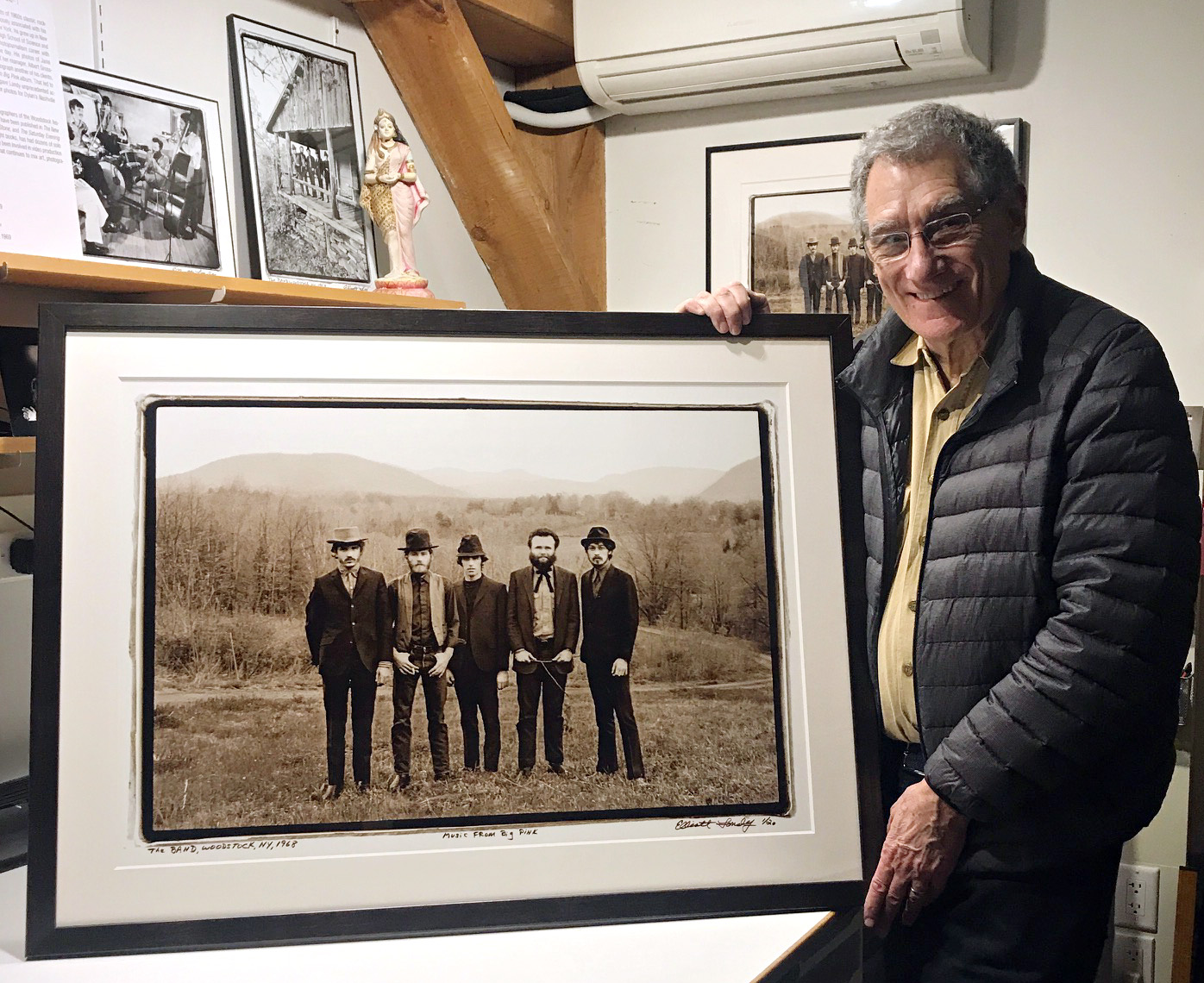
Elliot Landy with one of his iconic photos of The Band – Image courtesy of Elliot Landy.
I didn’t put it on a tripod. All cameras were on tripods in those years. I don’t like to work on a tripod, so I handheld it. If I had used the tripod, I could have had a two- or three-second exposure.
Somehow, because I handheld it, it has the look to it that makes it look very old-timey. It’s a bit out of focus. It’s a bit grainy. The intuitive decisions, or the not thinking decisions that I made – not to put it on a tripod – just because I didn’t want to. I had a tripod right there. I just didn’t want to.
I can’t really get the shot I want. I need to move around because I’m constantly reframing the picture when I’m photographing someone. So I used a contemporary camera. It was either Nikon or Leica; I used both at that time.
No, I don’t go back to old equipment, except for one time. That’s not entirely true. A few years back, I have these old screw-on fisheye lenses … you know, I may change my answer.
Rick: [Laughs] Okay, sure.
Elliott Landy: The fisheye lens, you screw on the front of a 50 mm lens. It gives you a certain look. I was playing with that for a while and then I guess I got bored with that and I use optical filters. I have a 5-prism filter. If you look on my website, there are pictures of flowers. You’ll see a lot of pictures there, but you can’t really tell what it’s taken with. It was taken with optical lenses that you screw in, so you don’t have to do everything in the computer.
I also own an actual kaleidoscope that’s called a camera scope that is made to take pictures with. A guy in Texas made them and no one else ever copied his style. It’s not really old-fashioned in terms of old equipment, but I don’t go back to film. I would be interested maybe and taking some photographs certainly if they had infrared color film. I’d shoot that, but they don’t make it anymore.
I’d be interested in shooting with film with a large film negative. The reality of it is that it takes a long time to do that. You’ve got to process the film and so on, and it would really need more sifting, more people than I have now to make it possible for me to take the time to do that. I’d love to use a film camera again for certain things actually, but at the moment I can’t dream of having the time do that.
Rick: Are there any new artists or performers that you’re drawn to in the same way that you were to The Band and maybe Dylan?
Elliott Landy: Well, I wasn’t drawn to The Band, because nobody had heard of them. It was before their first album. I loved Dylan. I was certainly an appreciator of his music, but I wasn’t a fan in terms of wanting to go to his concerts.
I mean, I guess I would have wanted to go to a concert, but it just didn’t turn up. They kind of came to me and asked me to photograph The Band after they had seen my pictures of Janis (Joplin). It’s very well-described in my book. I think if you read the text, you’ll really enjoy it.
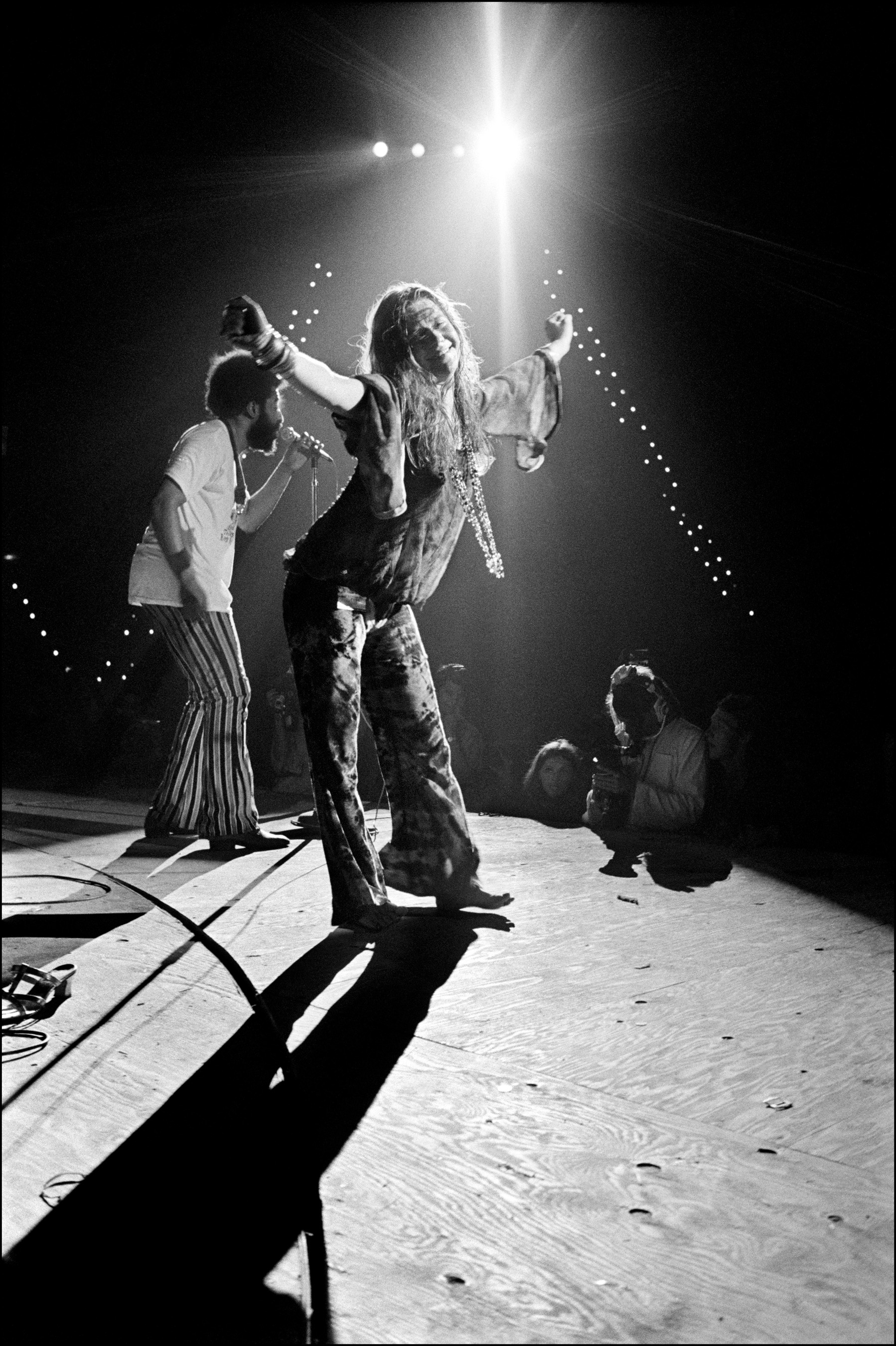
Janis Joplin, Woodstock Festival, Bethel, NY, 1969. Photo By ©Elliott Landy, LandyVision Inc.
Rick: Yeah, I’ll go through the book again because it’s been a while.
Elliott Landy: Albert asked me to photograph The Band and because of that, I got a call from a friend of Bob’s: Al Aronowitz, a really good journalist. He said, “We need a picture of Bob for the Saturday Evening Post. So, they came to me. Are there any popular people today? I don’t know actually. One of the problems is that when you listen to music on the radio, they don’t tell you who it is. They just play the next song.
Rick: Yeah, that’s true.
Elliott Landy: So I don’t know. I can’t really say that.
Rick: It sounds like the biggest thing you’ve got going at this point is probably the exhibits that you’re going to be putting out in Europe. That sounds like a pretty intense project, logistically.
Elliott Landy: Yes, it is. Bu,t the most important thing is this app on my films that I’m making, with the interactive films. That’s really the most important thing. I don’t have any investment in it. They’re all financed by myself, so I have to have a timetable for it. I’m hoping to get that out this year. I expect to, actually.
I have staff and people I work with because I don’t want to be in the app business. I don’t want to run an app. I don’t want to tech-support an app. I need someone to build it. I’m going over it, but it’s a burden right now. I need a tech person or I don’t know what. I’m putting it out to the universe.
Rick: Oh, cool. Do you have any dream projects that you’ve wanted to get to, but you haven’t gotten to yet? Something you wanted to do for a long time, and I know you’re doing one right now, but are there any others?
Elliott Landy: Well, this interactive music thing is also a theatrical film. I built this technology. To call it an app is to diminish it. It’s really a new type of editing system, in fact. Now that I have it working, I’m creating content. I’m creating films or videos with it and I want to make it into a theatrical film.
Beyond that, I want to create what I call interactive music cinemas. I was just talking to Linda, my wife, about having my own amusement park: Elliott Land Amusement Park – very different than the word “theme”.
It’s an amusement park to amuse yourself, or to be amused by it. This film work that I’m doing is really far out stuff, and the fact that you can take it and then reinvent it, people will go there and play their own music to it or choose between different music. It’s truly interactive.
I feel like it’s the Holy Grail that the music business has been looking for. I would then put my photographs in it. If you look on my website, you’ll see multiple genres of work in addition to this rock ‘n’ roll period.
I would put exhibitions up all the time that would change it, plus I’m doing really good new work, as well. The new stuff is totally different than other stuff I’ve done. So, I guess my dream project would be an Elliot Land Amusement Park.
CHECK OUT ELLIOT LANDY’S NEW KICKSTARTER CAMPAIGN FOR “CONTACTING THE BAND” BOOK!
